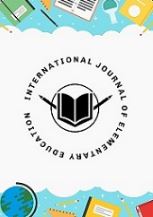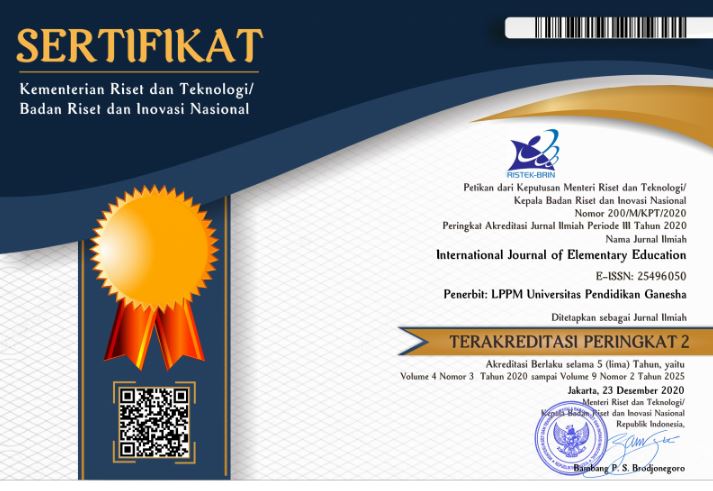The Use of NHT and TPS Assisted by Zoom Meetings on the Problem Solving Ability of Elementary School Students
DOI:
https://doi.org/10.23887/ijee.v6i4.47415Keywords:
Think Pair Share, Problem Solving, Elementary School, Natural Science, Number Head TogetherAbstract
Learning science in elementary schools still carried out conventionally which results in the lack of problem solving abilities in students. NHT and TPS are a kinds of methods that can support students’ problem solving abilities. This study was conducted to analysis the differences in students' science problem-solving abilities between the application of NHT and TPS learning materials for class IV public schools. This research was conducted in the form of experimental research using Quasy Experimental Design. The design used is Non Equivalent Control Group Posttest Design. The population in this study were 58 students in class IV. Sampling was carried out using a saturated sample technique in class IV A with a total of 28 students as experimental class I (NHT) and Class IV B with a total of 30 students being treated with TPS. The data collection technique used a test in the form of a posttest. These results indicate that there are dissimilarities or differences between the problem-solving abilities of fourth-grade students in experimental class I (NHT) and practical class II (TPS), especially in sound material. The NHT model that is applied has more influence on students' problem-solving abilities in the teaching and learning process compared to the TPS model.
References
Anggraini, L. A., Arif, S., Muna, I. A., & Aristiawan, A. (2021). Pengaruh Model Pembelajaran Numbered Head Together (NHT) Berbasis STEM dalam Meningkatkan Kemampuan Metakognisi. Jurnal Tadris IPA Indonesia, 1(2), 219–227. https://doi.org/10.21154/jtii.v1i2.199.
Anggreni, P. F., Asri, I. A. S., & Ganing, N. N. (2017). Pengaruh Model Pembelajaran Kooperatif Tipe Think- Pair-Share ( Tps ) Berbantuan Media Kartu Bergambar Terhadap Penguasaan Kompetensi Pengetahuan Ips Siswa Kelas V Gugus Letkol Wisnu. Mimbar PGSD, 5(2), 1–10. https://doi.org/10.23887/jjpgsd.v5i2.10645.
Asmahasanah, S., Ibdalsyah, I., & Sa’diyah, M. (2018). Social Studies Education in Elementary Schools Through Contextual REACT-Based on Environment and Sociopreneur. International Journal of Multicultural and Multireligious Understanding, 5(6), 52. https://doi.org/10.18415/ijmmu.v5i6.487.
Assidiqi, M. H., & Sumarni, W. (2020). Pemanfaatan Platform Digital di Masa Pandemi Covid-19. Prosiding Seminar Nasional Pascasarjana, 298–303. https://proceeding.unnes.ac.id/index.php/snpasca/article/download/601/519.
Astuti, W. (2019). Pengaruh Model Numbered Heads Together (NHT) Terhadap Motivasi Belajar dan Hasil Belajar IPS Siswa Kelas III Sekolah Dasar. Jurnal Basicedu, 3(2), 605–610. https://doi.org/10.31004/basicedu.v3i2.45.
Cavus, N., & Alhih, M. S. (2014). Learning Management Systems Use in Science Education. Procedia - Social and Behavioral Sciences, 143. https://doi.org/10.1016/j.sbspro.2014.07.429.
Chasanah, A. N. (2019). Cognitive Growth Learning Model to Improve the Students’ Critical Thinking Skills. JRAMathEdu (Journal of Research and Advances in Mathematics Education), 4(2), 112–123. https://doi.org/10.23917/jramathedu.v4i2.8127.
Colliver, Y. (2018). Fostering young children’s interest in numeracy through demonstration of its value: the Footsteps Study. Mathematics Education Research Journal, 30(4), 407–428. https://doi.org/10.1007/s13394-017-0216-4.
Etobro, A. B., & Fabinu, O. E. (2017). Students’ Perceptions of Difficult Concepts in Biology in Senior Secondary Schools in Lagos State. Global Journal of Educational Research, 16(2), 139. https://doi.org/10.4314/gjedr.v16i2.8.
Fitriansyah, R., Fatinah, L., & Syahril, M. (2020). Critical Review: Professional Development Programs to Face Open Educational Resources in Indonesia. Indonesian Journal on Learning and Advanced Education (IJOLAE), 2(2), 109–119. https://doi.org/10.23917/ijolae.v2i2.9662.
Giselsson, K. (2020). Critical Thinking and Critical Literacy: Mutually Exclusive? International Journal for the Scholarship of Teaching and Learning, 14(1), 1–9. https://doi.org/10.20429/ijsotl.2020.140105.
Imam, I., Ayubi, A., & Bernard, M. (2018). Pengaruh Pembelajaran Berbasis Masalah Terhadap Kemampuan Pemecahan Masalah Matematis Siswa SMA. JPMI:Jurnal Pembelajaran Matematika Inovatif, 1(3), 355–360. https://doi.org/10.22460/jpmi.v1i3.355-360.
Juliartini, N. M., & Arini, N. W. (2017). Penerapan Model Pembelajaran Nht Untuk Meningkatkan Hasil Belajar Ipa Siswa Kelas III. Journal of Education Action Research, 1(3), 240. https://doi.org/10.23887/jear.v1i3.12688.
Kadek Yogi Parta, L. P. S. W. (2016). Pengaruh Model Dan Media Pembelajaran Terhadap Hasil Belajar Kemampuan Dasar Senam Lantai Pada Mahasiswa Jurusan Penjaskesrek Undiksha. JPI (Jurnal Pendidikan Indonesia), 5(1), 97. https://doi.org/10.23887/jpi-undiksha.v5i1.8932.
Kartikasari, A., Roemintoyo, R., & Yamtinah, S. (2018). The Effectiveness of Science Textbook Based on Science Technology Society for Elementary School Level. International Journal of Evaluation and Research in Education (IJERE), 7(2), 127–131. https://doi.org/10.11591/ijere.v7i2.13022.
Kelana, J. B., Wulandari, M. A., & Wardani, D. S. (2021). Penggunaan Aplikasi Zoom Meeting di Masa Pandemi Covid-19 Pada Pembelajaran Sains. Jurnal Elementary: Kajian Teori Dan Hasil Penelitian Pendidikan Sekolah Dasar, 4(1), 18–22. https://doi.org/10.31764/elementary.v4i1.3520.
Kibirige, I., & Teffo, W. L. (2014). Actual and Ideal Assessment Practices in South African Natural Sciences Classrooms. International Journal of Educational Sciences, 6(3), 509–519. https://doi.org/10.31901/24566322.2014/06.03.1.
Kurnia, V. T., & Damayani, A. T. (2019). Keefektifan Model Pembelajaran Number Head Together ( NHT ) Berbantu Media Puzzle Terhadap Hasil Belajar Matematika. Jurnal Ilmiah Sekolah Dasar, 3(2), 192–201. https://doi.org/10.23887/jisd.v3i2.17772.
Kurniawan, D. A., Astalini, A., Darmaji, D., & Melsayanti, R. (2019). Students’ Attitude towards Natural Sciences. ,. International Journal of Evaluation and Research in Education, 8(3), 455–460. https://eric.ed.gov/?id=EJ1232323.
Leasa, M., Fenanlampir, A., Batlolona, J. R., & Saimima, A. S. (2021). Problem-solving and creative thinking skills with the PBL model: The concept of the human circulatory system. Biosfer, 14(2), 154–166. https://doi.org/10.21009/biosferjpb.20825.
Madu, B. C. (2020). Scientific Explanation of Phenomenon, Imagination and Concept Formation as Correlates of Students’ Understanding of Physics Concepts. Journal of Natural Sciences Research, 11(16), 17–28. https://doi.org/10.7176/jnsr/11-16-03.
Maman, M., & Rajab, A. A. (2016). The Implementation of Cooperative Learning Model ‘Number Heads Together (NHT)’ in Improving the Students’ Ability in Reading Comprehension. International Journal of Evaluation and Research in Education (IJERE), 5(2), 174–180. https://doi.org/10.11591/ijere.v5i2.4536.
Meilana, S. F., Aulia, N., Zulherman, Z., & Aji, G. B. (2020). Pengaruh Model Pembelajaran Think Pair Share (TPS) terhadap Kemampuan Berpikir Kritis di Sekolah Dasar. Jurnal Basicedu, 5(1), 218–226. https://doi.org/10.31004/basicedu.v5i1.644.
Mouromadhoni, K. R., Prasetyo, Z. K., & Atun, S. (2019). Development Student Activity Sheet of Natural Sciences with Authentic Inquiry Learning Approach to Improve Problemsolving Skills of Junior High School Students. Journal of Physics: Conference Series, 1233(1). https://doi.org/10.1088/1742-6596/1233/1/012092.
Mufarizuddin. (2018). Improving learning outcomes by using Think Pair Share (TPS) cooperative learning model at primary school students. Jurnal Pendidikan Indonesia, 7(2), 77–85. https://doi.org/10.23887/jpi-undiksha.v7i2.10469.
Muzaki, A., & Masjudin, M. (2019). Analisis Kemampuan Literasi Matematis Siswa. Mosharafa: Jurnal Pendidikan Matematika, 8(3), 493–502. https://doi.org/10.31980/mosharafa.v8i3.557.
Ningsih, I., Winarni, R., & Roemintoyo, R. (2019). Implementation of Digital Literacy to Achieve 21st Century Skills in The 2013’s Curriculum. https://doi.org/10.4108/eai.27-4-2019.2286855.
Novayulianti, R. S. H. (2021). Analisis Aktivitas Belajar Siswa Pada Mata Pelajaran IPA Kelas V di SDN Duri Kepa 05 Dalam Masa Pandemi Covid-19. Jurnal Inovasi Pendidikan, 2(3), 987–996. https://doi.org/https://doi.org/10.47492/jip.v2i3.793.
Nugraha, W. S. (2018). Peningkatan Kemampuan Berpikir Kritis Dan Penguasaan Konsep Ipa Siswa Sd Dengan Menggunakan Model Problem Based Learning. EduHumaniora | Jurnal Pendidikan Dasar Kampus Cibiru, 10(2), 115. https://doi.org/10.17509/eh.v10i2.11907.
Pramestika, M. C., Muslim, A., & Eka, K. I. (2019). Meningkatkan Sikap Tanggung Jawab dan Prestasi Belajar Melalui Model Pembelajaran Tipe Number Head Together (NHT) Berbantu Video Stop Motion. Ar-Riiayah, Jurnal Pendidikan Dasar, 7(2), 98–108. https://doi.org/10.46368/jpd.v7i2.165.
Rochman, C., Nasudin, D., & Rokayah, R. (2019). Science literacy on science technology engineering and math (STEM) learning in elementary schools. Journal of Physics: Conference Series, 1318(1). https://doi.org/10.1088/1742-6596/1318/1/012050.
Rostika, D., & Junita, H. (2017). Peningkatan Kemampuan Pemecahan Masalah Siswa SD dalam Pembelajaran Matematika dengan Model Diskursus Multy Representation (DMR). EduHumaniora : Jurnal Pendidikan Dasar, 9(1), 35–46. https://doi.org/10.17509/eh.v9i1.6176.
Sadikin, A., & Hamidah, A. (2020). Pembelajaran Daring di Tengah Wabah Covid-19. Biodik, 6(2), 109–119. https://doi.org/10.22437/bio.v6i2.9759.
Simanungkalit, M. (2021). Penerapan Pembelajaran Aktif Kooperatif Melalui Metode Numbered Head Together (NHT) Sebagai Upaya Meningkatkan Aktivitas Dan Hasil Belajar Ipa - Biologi. Jurnal Teknologi Informasi & Komunikasi Dalam Pendidikan, 7(1), 89. https://doi.org/10.24114/jtikp.v7i1.22635.
Sudewiputri, M. P., & Dharma, I. M. A. (2021). Model Pembelajaran Numbered Heads Together (NHT) Terhadap Motivasi dan Hasil Belajar IPA. Jurnal Pedagogi Dan Pembelajaran, 4(2). https://doi.org/10.23887/jp2.v4i2.36193.
Susanti, A., & Kristin, F. (2021). Efektivitas Penggunaan Google classroom dan Zoom Cloud Meeting Terhadap Minat Belajar IPS. MIMBAR PGSD Undiksha, 9(3), 367. https://doi.org/10.23887/jjpgsd.v9i3.39658.
Tanti, T., Kurniawan, D. A., Syefrinando, B., Daryanto, M., & Fitriani, R. S. (2021). Identification of students attitudes towards natural sciences at Adhyaksa 1 Junior High School, Jambi City. Journal of Education and Learning (EduLearn), 15(1), 19–26. https://doi.org/10.11591/edulearn.v15i1.16377.
Tusyana, E., & Luciana, D. (2019). Pengaruh Model Pembelajaran Kooperatif Tipe Numbered Heads Together Terhadap Hasil Belajar Pkn. TERAMPIL: Jurnal Pendidikan Dan Pembelajaran Dasar, 6(2), 173–184. https://doi.org/10.24042/terampil.v6i2.4812.
Ulya, S., Hindarto, N., & Nurbaiti, U. (2013). Keefektifan Model Pembelajaran Guided Inquiry Berbasis Think Pair Share (TPS) dalam Meningkatkan Pemahaman Konsep Fisika Kelas XI SMA. UPEJ Unnes Physics Education Journal, 2(3). https://doi.org/10.15294/upej.v2i3.2926.
Utami, D. A., Irianto, S., & Muryaningsih, S. (2020). Pengembangan Handout Kurikulum 2013 Berbasis Kompetensi Peserta Didik Abad 21 Kelas IV Di Sd Negeri Kembaran. Al Qalam: Jurnal Ilmiah Keagamaan Dan Kemasyarakatan, 14(2), 151. https://doi.org/10.35931/aq.v14i2.386.
Utaminingsih, R., Rahayu, A., & Andini, D. W. (2018). Pengembangan RPP IPA sekolah dasar berbasis problem-based learning untuk siswa learning disabilities Development of primary school natural science lesson plan based on problem-based learning for learning disabilities students. Jurnal Inovasi Pendidikan IPA, 4(2), 191–202. https://doi.org/10.21831/jipi.v4i2.21401.
Wahyuni, L. T. S., Japa, I. G. N., & Rati, N. W. (2020). Correlation of Reading Interests and Learning Motivation Toward Science Learning Outcomes. Jurnal Ilmiah Sekolah Dasar, 4(3), 484. https://doi.org/10.23887/jisd.v4i3.25376.
Wati, N. K. S., & Suarni, N. K. (2020). Social Studies Learning With Numbered Head Together Model Improves Learning Outcomes Viewed From Student Learning Motivation. International Journal of Elementary Education, 4(2), 244. https://doi.org/10.23887/ijee.v4i2.25250.
Widowati, A., Nurohman, S., & Anjarsari, P. (2017). Developing science learning material with authentic inquiry learning approach to improve problem solving and scientific attitude. Jurnal Pendidikan IPA Indonesia, 6(1), 32–40. https://doi.org/10.15294/jpii.v6i1.4851.
Yamin, M. R., & Karmila. (2020). Analisis Kebutuhan Pengembangan Media Pembelajaran Berbasis Cartoon dalam Pembelajaran IPA pada Materi Lingkungan Kelas III SD. Biology Teaching and Learning, 2(2), 159–170. https://doi.org/10.35580/btl.v2i2.12307.
Yenni, R. F. (2016). Penggunaan metode numbered head Together ( NHT ) dalam pembelajaran matematika. Jurnal Penelitian Dan Pembelajaran Matematika, 9(2), 263–267. https://doi.org/10.30870/jppm.v9i2.1006.
Yu, H., Liu, P., Huang, X., & Cao, Y. (2021). Teacher Online Informal Learning as a Means to Innovative Teaching During Home Quarantine in the COVID-19 Pandemic. Frontiers in Psychology, 12(June), 1–12. https://doi.org/10.3389/fpsyg.2021.596582.
Downloads
Published
How to Cite
Issue
Section
License
Copyright (c) 2022 Sri Lestari Handayani

This work is licensed under a Creative Commons Attribution-ShareAlike 4.0 International License.
Authors who publish with the International Journal of Elementary Education agree to the following terms:
- Authors retain copyright and grant the journal the right of first publication with the work simultaneously licensed under a Creative Commons Attribution License (CC BY-SA 4.0) that allows others to share the work with an acknowledgment of the work's authorship and initial publication in this journal.
- Authors are able to enter into separate, additional contractual arrangements for the non-exclusive distribution of the journal's published version of the work (e.g., post it to an institutional repository or publish it in a book), with an acknowledgment of its initial publication in this journal.
- Authors are permitted and encouraged to post their work online (e.g., in institutional repositories or on their website) prior to and during the submission process, as it can lead to productive exchanges, as well as earlier and greater citation of published work. (See The Effect of Open Access)









